Restored in 2023 by The Film Foundation’s World Cinema Project and Cineteca di Bologna in collaboration with the National Film Organization and the family of Tewfik Saleh. Special thanks to Mohamed Challouf and Nadi Nekol Nas. Funding provided by the Hobson/Lucas Family Foundation.

The World Cinema Project (WCP) preserves and restores neglected films from around the world. To date, 63 films from Africa, Asia, Eastern Europe, Central America, South America, and the Middle East have been restored, preserved and exhibited for a global audience. The WCP also supports educational programs, including Restoration Film Schools; intensive, results-oriented workshops allowing students and professionals worldwide to learn the art and science of film restoration and preservation. All WCP titles are available for exhibition rental by clicking "Book This Film."
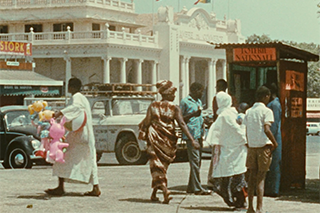
CONTRAS' CITY
CITY OF CONTRASTS
Director: Djibril Diop Mambéty
WRITTEN BY: Djibril Diop Mambéty
EDITING: Jean-Bernard Bonis, Marino Rio
DIRECTOR OF PHOTOGRAPHY: Georges Bracher
COUNTRY OF PRODUCTION: Senegal
LANGUAGE: Wolof with English Subtitles
COLOR INFO: Color
RUNNING TIME: 22 minutes
Restored in 2020 by Cineteca di Bologna/L'Immagine Ritrovata and The Film Foundation's World Cinema Project in association with The Criterion Collection. Funding provided by the Hobson/Lucas Family Foundation.
This restoration is part of the African Film Heritage Project, an initiative created by The Film Foundation’s World Cinema Project, the Pan African Federation of Filmmakers and UNESCO – in collaboration with Cineteca di Bologna – to help locate, restore, and disseminate African cinema.
NOTES ON THE RESTORATION:
The 4K restoration of CONTRAS' CITY was made from the internegative as well as the original sound negatove provided by Teemour Mambéty and preserved at LTC Patrimoine. A vintage print of the film was used as reference for color grading.
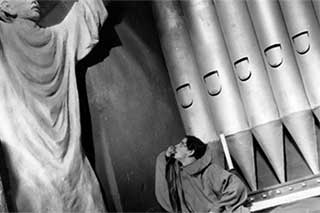
DOS MONJES
TWO MONKS
Director: Juan Bustillo Oro
WRITTEN BY: Juan Bustillo Oro, José Manuel Cordero
EDITING: Juan Bustillo Oro
DIRECTOR OF PHOTOGRAPHY: Agustín Jiménez
PRODUCER: José San Vicente, Manuel San Vicente
MUSICAL DIRECTOR: Max Urban
PRODUCTION DESIGN: Mariano Rodríguez, Granada, Carlos Toussaint
STARRING: Víctor Urruchúa, Carlos Villatoro, Beltrán de Heredia, Emma Roldán, Magda Haller
COUNTRY OF PRODUCTION: Mexico
LANGUAGE: Spanish with English subtitles
COLOR INFO: Black and White
RUNNING TIME: 85 minutes
PRODUCTION COMPANY: Proa Films
PRODUCER: José San Vicente, Manuel San Vicente
Restored by The Film Foundation’s World Cinema Project at L’immagine Ritrovata laboratory in collaboration with Filmoteca de la UNAM and Cinémathèque française. Restoration funded by the Material World Charitable Foundation.
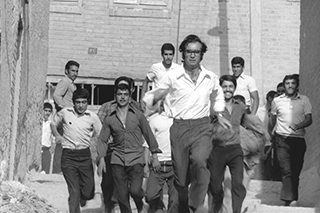
Downpour
RAGBAR
Director: Bahram Beyzaie
WRITTEN BY: Bahram Beyzaie
EDITING: Mehdi Rajaeeyan
DIRECTOR OF PHOTOGRAPHY: Barbod Taheri
PRODUCER: Barbod Taheri
MUSICAL DIRECTOR: Shida Garachedaghi
STARRING: Parviz Fannizadeh, Parvaneh Masumi, Manuchehr Farid, Mohammad Ali Keshavarz, Hossein Kasbian, Jamsheed Layegh, Chehrazad
COUNTRY OF PRODUCTION: Iran
LANGUAGE: Persian
COLOR INFO: Black and White
RUNNING TIME: 129 minutes
PRODUCTION COMPANY: Mehregan Film
PRODUCER: Barbod Taheri
Restored in 2011 by Cineteca di Bologna/L’Immagine Ritrovata laboratory, in association with The Film Foundation’s World Cinema Project and Bahram Beyzaie. Restoration funded by Doha Film Institute.
During Downpour, the equations of commercial and intellectual films were the same. The common morality of the action/drama films of the commercial cinema had a tone of political ideology and social activism. The intellectual films were praised for communicating with the mass culture. In that sense, I don’t want to be popular. Many of these (popular) moralities, in my opinion, are wrong and we are all victims of them. So, I have betrayed my people if I endorse them. I have deviated from the morals of the political parties, hence they have labeled me (inaccessible), not the people. At the heart of my harsh expression, there is a love and respect, for the people, that does not exist in superficial appraisals of the masses. … my audiences are those who strive to go one step further, not those who are the guardians of the old equations nor those who dread self examination and self reflexivity.
–Bahram Beyzaie
I’m very proud that the World Cinema Foundation has restored this wise and beautiful film, the first feature from its director Bahram Beyzaie. The tone puts me in mind of what I love best in the Italian neorealist pictures, and the story has the beauty of an ancient fable – you can feel Beyzaie’s background in Persian literature, theater and poetry. Beyzaie never received the support he deserved from the government of his home country – he now lives in California – and it’s painful to think that this extraordinary film, once so popular in Iran, was on the verge of disappearing forever. The original negative has been either impounded or destroyed by the Iranian government, and all that remained was one 35mm print with English subtitles burned in. Now, audiences all over the world will be able to see this remarkable picture.
–Martin Scorsese
NOTES ON THE RESTORATION:
The source element was a positive print with English subtitles provided by director Bahram Beyzaie. Since this is the only known surviving copy of the film – all other film sources were seized and are presumed destroyed – the restoration required a considerable amount of both physical and digital repair.
The surviving print was badly damaged with scratches, perforation tears and mid-frame splices. Over 1500 hours of work were necessary to complete the restoration.
Image: © Courtesy of Bahram Beyzaie
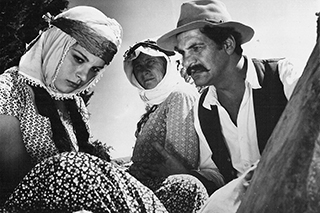
DRY SUMMER
SUSUZ YAZ
Director: Metin Erksan
WRITTEN BY: Necati Cumali, Metin Erksan Kemal Ínci, Ísmet Soydan
EDITING: Turgut Ínangiray
DIRECTOR OF PHOTOGRAPHY: Ali Ugur
PRODUCER: Ulvi Dogan
MUSICAL DIRECTOR: Ahmet Yamaç
SOUND: Turgut Ínangiray
STARRING: Ulvi Dogan (Hassan), Erol Tas (Osman), Hülya Koçyigit (Bahar)
COUNTRY OF PRODUCTION: Turkey
LANGUAGE: Turkish with French and English subtitles
COLOR INFO: Black and White
RUNNING TIME: 75 minutes
PRODUCER: Ulvi Dogan
Restored in 2008 by Cineteca di Bologna/L’Immagine Ritrovata laboratory, in association with The Film Foundation’s World Cinema Project, Ulvi Dogan, and Fatih Akin. Additional elements provided by the Friedrich Wilhelm Murnau Stiftung. Restoration funded by Armani, Cartier, Qatar Airways and Qatar Museum Authority.
Dry Summer is a film of passion. A passion for water as well as the obsessive passion created by forbidden love. […] Dry Summer is a film of captivity… Authorities at the time objected to Dry Summer representing Turkey overseas, which presented all kinds of obstacles when the film came to the Berlin Film Festival. The film walked away with the Golden Bear, but before success could even be celebrated it was ‘taken captive’ and completely forgotten for the next 45 years. Today, in these times of intellectually dry summers, when greed is driving humanity to the brink of starvation, this film could hardly be more valid. Dry Summer is one of the most important legacies of Turkish cinema, and thanks to restoration it can be re-discovered by the next generations of audiences all over the world. –Fatih Akin, May 2008
NOTES ON THE RESTORATION:
The restoration of Susuz Yaz used the original 35mm camera negative and the original 17.5 mm sound negative and recaptured the black and white film’s tonal nuances. The film’s producer, Ulvi Dogan, provided the prints. An interpositive preserved at the Friedrich Wilhelm Murnau Stiftung in Wiesbaden was used for the negative’s last missing reel. The opening and closing credits, missing from all available sources, have been digitally reconstructed.
Image: © Courtesy of Ulvi Doğan
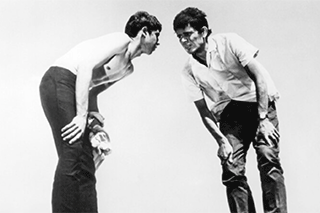
DUPES, THE
AL-MAKHDU’UN
Director: Tewfik Saleh
WRITTEN BY: Tewfik Saleh
EDITING: Farin Dib, Saheb Haddad
DIRECTOR OF PHOTOGRAPHY: Bahgat Heidar
STARRING: Mohamed Kheir-Halouani, Abderrahman Alrahy, Bassan Lofti Abou-Ghazala, Saleh Kholoki, Thanaa Debsi
COUNTRY OF PRODUCTION: Syria
LANGUAGE: Arabic with English subtitles
RUNNING TIME: 107 minutes
NOTES ON THE RESTORATION:
The 4K restoration used a 35mm dupe negative preserved by the Bulgarian National Film Archive (Bulgarska Nacionalna Filmoteka) and was completed in 2023 by L’Immagine Ritrovata laboratory.
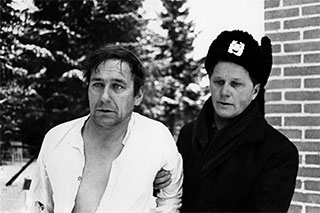
EIGHT DEADLY SHOTS
KAHDEKSAN SURMANLUOTIA
Director: Mikko Niskanen
WRITTEN BY: Mikko Niskanen
DIRECTOR OF PHOTOGRAPHY: Mikko Niskanen
STARRING: Tarja-Tuulikki Tarsala, Mikko Niskanen, Paavo Pentikäinen, Tauno Paananen. Elina Liimatainen, Ari Vainiontaus, Mauno Argillander, Sulo Hokkanen
COUNTRY OF PRODUCTION: Finland
LANGUAGE: Finnish with English subtitles
COLOR INFO: Black and White
RUNNING TIME: 316 minutes
Restored by The Film Foundation's World Cinema Project, Yleisradio Oy, Fiction Finland ry, and Fondazione Cineteca di Bologna at L'Immagine Ritrovata laboratory. Funding provided by the Hobson/Lucas Family Foundation. Additional support provided by The Ministry of Culture and Education in Finland, Tiina and Antti Herlin Foundation, and the Jane and Aatos Erkko Foundation.
NOTES ON THE RESTORATION:
EIGHT DEADLY SHOTS was originally broadcast in Finland as a 4-part television series by the national public broadcasting company of Finland, YLE. The late film historian and filmmaker Peter von Bagh first discovered and disseminated the work of Mikko Niskanen and was a tireless advocate for this film's restoration. Due to von Bagh's championing, Niskanen is recognized as one of Finland's most revered auteurs.
The digital restoration was completed using a 4K scan of the original 16mm one perforation A/B roll negatives preserved by Yleisradio Oy.
In addition to digital restoration, and in order to be as faithful as possible to the original 16mm look and texture, a new fine grain was created and used to generate a duplicate negative. Finally, two new 35mm prints were struck for circulation and preservation.
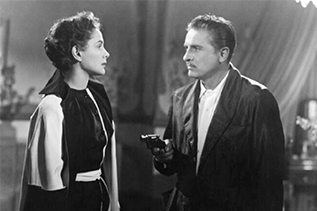
ÉL
Director: Luis Buñuel
WRITTEN BY: Luis Buñuel, Luis Alcoriza
EDITING: Carlos Savage
DIRECTOR OF PHOTOGRAPHY: Gabriel Figueroa
ADAPTED BY: Luis Buñuel, Luis Alcoriza
PRODUCER: Óscar Dancigers
PRODUCTION DESIGN: Edward Fitzgerald
STARRING: Arturo de Córdova, Delia Garcés, Aurora Walker, Carlos Martínez Baena, Manuel Dondé, Rafael Banquell, Fernando Casanova, Luis Beristáin
COUNTRY OF PRODUCTION: Mexico
LANGUAGE: Spanish with English subtitles
COLOR INFO: Black and White
RUNNING TIME: 82 minutes
PRODUCER: Óscar Dancigers
Restored by The Film Foundation's World Cinema Project, Les Films du Camélia and Cineteca di Bologna at L'Immagine Ritrovata Laboratory, with the support of OCS and in association with Películas y Videos Internacionales.
Special thanks to Guillermo del Toro.
Funding provided by the Material World Foundation.
NOTES ON THE RESTORATION:
The 4K restoration used the dupe positive preserved by Películas y Videos Internacionales at the Filmoteca de la UNAM, where the scan was performed. Color grading was supervised by Gabriel Figueroa Flores.
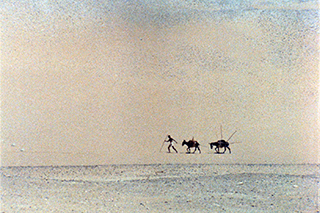
ELOQUENT PEASANT, THE
SHAKAVI EL FLASH EL FASI
Director: Shadi Abdel Salam
WRITTEN BY: Shadi Abdel Salam
EDITING: Kamal Abou El Ella
STARRING: Ahmed Marei (Peasant); Ahmed Enan (The Great Stewart); Ahmed Hegazi (Thutenakht)
COUNTRY OF PRODUCTION: Egypt
LANGUAGE: Arabic
COLOR INFO: Color
RUNNING TIME: 21 minutes
Restored in 2010 by Cineteca di Bologna/L’Immagine Ritrovata laboratory, in association with The Film Foundation’s World Cinema Project, and the Egyptian Film Center. Restoration funded by Armani, Cartier, Qatar Airways and Qatar Museum Authority.
Based on one of the major literary texts survived from the Middle Kingdom, the classical period of Egyptian literature, The Eloquent Peasant is a combination of a morality/folk tale and a poem. The events are set between 2160 and 2025 BC. When the peasant Khun-anup and his donkey stumble upon the lands of the noble Rensi, the peasant’s goods are confiscated and he’s unjustly accused of theft. The peasant petitions Rensi who is so taken by the peasant’s eloquence that he report his astonishing discovery to the king. The king realises the peasant has been wronged but delays judgement so as to he can hear more of his eloquence. The peasant makes a total of nine petitions until finally, his goods are returned.
NOTES ON THE RESTORATION:
The Eloquent Peasant has been restored using the original 35mm camera and sound negatives preserved at the Egyptian Film Center in Giza. The digital restoration produced a new 35 mm internegative. Special thanks to the Bibliotheca Alexandrina.
Image: © Courtesy of Egyptian Film Centre
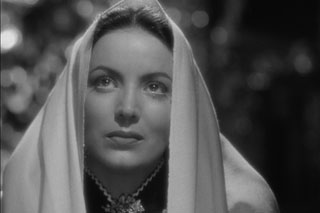
ENAMORADA
Director: Emilio Fernández
WRITTEN BY: Iñigo de Martino, Emilio Fernández
EDITING: Gloria Schoemann
DIRECTOR OF PHOTOGRAPHY: Gabriel Figueroa
PRODUCER: Benito Alazraki Franco
MUSICAL DIRECTOR: Eduardo Hernández Moncada
SOUND: José B. Carles
ART DIRECTOR: Manuel Parra
PRODUCTION DESIGN: Manuel Fontanals
STARRING: María Félix, Pedro Armendáriz, Fernando Fernández
COUNTRY OF PRODUCTION: Mexico
LANGUAGE: Spanish with English subtitles
COLOR INFO: Black and White
RUNNING TIME: 99 minutes
PRODUCTION COMPANY: Panamerican Films, S.A.
SET DESIGNER: Manuel Parra
PRODUCER: Benito Alazraki Franco
Restored by UCLA Film & Television Archive and The Film Foundation’s World Cinema Project in collaboration with Fundacion Televisa AC and Filmoteca de la UNAM. Restoration funded by the Material World Charitable Foundation.
NOTES ON THE RESTORATION:
The 4K restoration of ENAMORADA utilized the original 35mm nitrate picture and track negatives stored by Televisa at Filmoteca de la UNAM in Mexico City. A 35mm nitrate print, provided by Filmoteca de la UNAM, was also used as a secondary element. 4K scanning and restoration was completed by Roundabout Entertainment and the audio restoration was completed by Audio Mechanics.
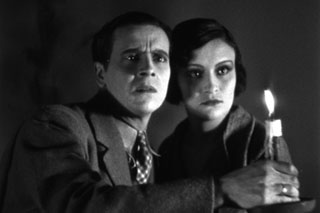
FANTASMA DEL CONVENTO, EL
Director: Fernando de Fuentes
WRITTEN BY: Jorge Bezet, Fernando de Fuentes, Juan Bustillo Oro
DIRECTOR OF PHOTOGRAPHY: Ross Fisher
PRODUCER: Jorge Bezet
STARRING: Enrique del Campo, Marte Roel, Carlos Villatoro, Paco Martínez, Victorio Blanco
COUNTRY OF PRODUCTION: Mexico
LANGUAGE: Spanish with English subtitles
COLOR INFO: Black and White
RUNNING TIME: 85 minutes
PRODUCER: Jorge Bezet
Restored by UCLA Film & Television Archive and The Film Foundation’s World Cinema Project, with funding provided by the George Lucas Family Foundation.
NOTES ON THE RESTORATION:
Preserved from the 35mm nitrate picture and track negatives and a 16mm acetate composite dupe negative. Laboratory services by Fotokem, Roundabout Entertainment, Inc., Audio Mechanics, DJ Audio, Inc., Titrafilm Paris. Special thanks to Viviana Garcia Besne, Permanencia Voluntaria; Albino Álvarez Gómez, Filmoteca de la UNAM.
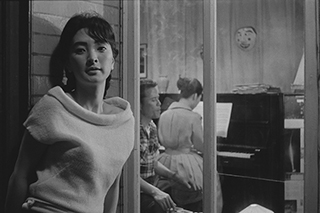
HOUSEMAID, THE
HANYO
Director: Kim Ki-Young
WRITTEN BY: Kim Ki-Young
EDITING: Kim Ki-Young
DIRECTOR OF PHOTOGRAPHY: Kim Deok-jin
PRODUCER: Kim Young-chul
MUSICAL DIRECTOR: Han Sang-Ki
ART DIRECTOR: Park Seok-in
STARRING: Lee Eunshim (Housemaid), Kim Jin-kyu (Dong-sik), Ju Jeung-nyeo (Dong-sik’s wife), Um Aeng-ran (Cho Kyung-hee)
COUNTRY OF PRODUCTION: South Korea
LANGUAGE: Korean with English subtitles
COLOR INFO: Black and White
RUNNING TIME: 110 minutes
PRODUCTION COMPANY: Korean Munye Films Co., Ltd.
PRODUCER: Kim Young-chul
Restored in 2008 by the Korean Film Archive (KOFA), in association with The Film Foundation's World Cinema Project and HFR-Digital Film laboratory. Additional restoration funded by Armani, Cartier, Qatar Airways and Qatar Museum Authority.
Kim Ki-young’s Hanyo, or The Housemaid, is one of the true classics of South Korean cinema, and when I finally had the opportunity to see the picture, I was startled. That this intensely, even passionately claustrophobic film is known only to the most devoted film lovers in the west is one of the great accidents of film history. I’m proud that the World Cinema Foundation is participating in the restoration and preservation of this remarkable picture. I am eager for more people to get to know and love The Housemaid.
–Martin Scorsese, February 2008
NOTES ON THE RESTORATION:
Hanyo has been restored digitally by the Korean Film Archive (KOFA) with the support of the World Cinema Foundation. The original negative of the film was found in 1982 with two missing reels, 5 and 8. In 1990 an original release print with hand-written English subtitles was found and used to complete the copy. This surviving print was highly damaged, and the English subtitles occupied almost half of the frame area. The long and complex restoration process has involved the use of a special subtitle-removal software and included flicker and grain reduction, scratch and dust removal, color grading.
Image: © Courtesy of Korean Film Archive
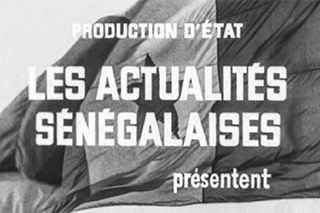
IFE / 3ÈME FESTIVAL DES ARTS
Director: Paulin Soumanou Vierya
COUNTRY OF PRODUCTION: Senegal
LANGUAGE: French with English subtitles
COLOR INFO: Black and White
RUNNING TIME: 13 minutes
Restored by The Film Foundation’s World Cinema Project and Cineteca di Bologna at L’Immagine Ritrovata laboratory, in collaboration with the Ministère de la Culture et du Patrimoine Historique de Sénégal – Direction du Cinéma. Restoration funded by the Hobson/Lucas Family Foundation.
This restoration is part of the African Film Heritage Project, an initiative created by The Film Foundation's World Cinema Project, the Pan African Federation of Filmmakers and UNESCO―in collaboration with Cineteca di Bologna―to help locate, restore, and disseminate African cinema.
NOTES ON THE RESTORATION:
The 4K restoration was completed using a 16mm print preserved by the Direction du Cinéma in Senegal. With special thanks to Tiziana Manfredi and Marco Lena.
